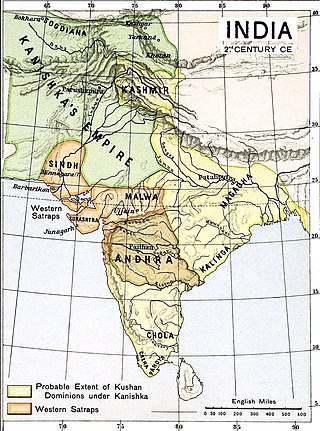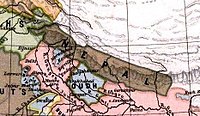Daradas were an ancient people who lived north and north-west to the Kashmir Valley. This kingdom is identified to be the Gilgit region, in the Gilgit-Baltistan region along the river Sindhu or Indus. They are often spoken along with the Kambojas. The Pandava hero Arjuna had visited this country of Daradas during his northern military campaign to collect tribute for Yudhishthira's Rajasuya sacrifice.
The Chinas are a people mentioned in ancient Indian literature, such as the Mahabharata, Manusmriti, and the Puranic literature.
Madra Kingdom was a kingdom grouped among the western kingdoms in the epic Mahabharata. Its capital was Sagala in Madra region, modern Sialkot in the Punjab province of Pakistan. The Kuru king Pandu's (Pāṇḍu) second wife was from Madra kingdom and was called Madri. The Pandava twins, Nakula and Sahadeva, were her sons. Madri's brother Shalya was the king of Madra. Though affectionate to the Pandavas, he was tricked to give support to Duryodhana and fought against the Pandavas during the Kurukshetra War. He was killed by Yudhishthira, the eldest Pandava. Other than the Madra kingdom with Sagala as its capital, it is believed that there was a Western Madra and a Northern Madra.
Kekeya Kingdom was a kingdom mentioned in the ancient Indian epic Mahabharata among the western kingdoms of then India. The epic Ramayana mentions one of the wives of Dasharatha, the king of Kosala and father of Rama, was from Kekeya kingdom and was known as Kaikeyi. Her son Bharata conquered the neighbouring kingdom of Gandhara and built the city of Takshasila. Later the sons and descendants of Bharata ruled this region from Takshasila.

Gandhāra was an ancient Indian kingdom mentioned in the Indian epics Mahabharata and Ramayana. Gandhara prince Shakuni was the root of all the conspiracies of Duryodhana against the Pandavas, which finally resulted in the Kurukshetra War. Shakuni's sister was the wife of the Kuru king Dhritarashtra and was known as Gandhari after the area of Gandhāra. Puskalavati, Takshasila (Taxila) and Purushapura (Peshawar) were cities in this Gandhara kingdom. Takshasila was founded by Rama's brother Bharata. Bharata's descendants ruled this kingdom afterwards. During the epic's period, the kingdom was ruled by Shakuni's father Suvala, Shakuni and Shakuni's son. Arjuna defeated Shakuni's son during his post-war military campaign for Yudhishthira's Aswamedha Yajna.
The Pahlava Kingdom is identified to be a kingdom of an Iranian tribe. The kingdom was well known, even during the campaign of Alexander. It was also mentioned in the epic Mahabharata.

The kingdom of Tushara, according to ancient Indian literature, such as the epic Mahabharata, was a land located beyond north-west India. In the Mahabharata, its inhabitants, known as the Tusharas, are depicted as mlechchas ("barbarians") and fierce warriors.
Sakas are described in Sanskrit sources as a Mleccha tribe grouped along with the Yavanas, Tusharas and Barbaras. There were a group of Sakas called Apa Sakas meaning water dwelling Sakas, probably living around some lake in central Asian steppes. Sakas took part in Kurukshetra War.
Khasas were a north western tribe mentioned in the epic Mahabharata.
Kasmira or Kashmira was a kingdom identified as the Kashmir Valley along the Jhelum River of modern Jammu and Kashmir. During the epic ages this was one among the territories of the Naga race. The Kasmiras were allies of the Kuru king Duryodhana.
Hunas were a tribe close to Himalayas that, because of limited interaction with Indian kingdoms, were mentioned in the epic Mahabharata. They belonged to the Xinjiang province of China, east of Jammu-Kashmir. However, they were nomadic people who changed their settlements from time to time.

Hara-Huna was an ancient kingdom and inhabited by the Hara Hunas tribe close to the Himalayas who had limited interaction with the Indian kingdoms, thus they were identified in the epic Mahabharata.

Andhra was a kingdom mentioned in the epics Ramayana and Mahabharata. It was a southern kingdom, currently identified as Indian state of Andhra Pradesh which got its name from.
Dravida is mentioned as one of the kingdoms in the southern part of present-day mainland India during the time of the Mahabharata.
Kanchi was a southern kingdom mentioned in the epic Mahabharata. This kingdom took part in the Kurukshetra War.
Parvata Kingdom refers to the territory of a tribe known as Parvatas (Mountaineers), mentioned in the epic Mahabharata. Most of the descriptions of Parvata kingdom in the epic refer to a mountainous country in the Himalayas. Tribes belonging to other mountainous regions in the north west, west and the east of the Indo-Gangetic Plain were also known as Parvatas, when used as a collective name. Parvatas took part in the Kurukshetra War. The epic also mentions a sage named Parvata who was a companion of sage Narada.

The Pahlavas are a people mentioned in ancient Indian texts. According to Patrick Carnegy, a Raj-era ethnographer, the 4th-century BCE Vartika of Katyayana mentions the Sakah-Parthavah, demonstrating an awareness of these Saka-Parthians, probably by way of commerce. Knowledge of the Pahlavas is distilled from the literary references in texts like the Manu Smriti, various Puranas, the Ramayana, the Mahabharata, and the Bṛhat Saṃhitā.
The Bahlikas were the inhabitants of Bahlika, mentioned in Atharvaveda, Mahabharata, Ramayana, Puranas, Vartikka of Katyayana, Brhatsamhita, Amarkosha etc. and in the ancient Inscriptions. The other variations of Bahlika are Bahli, Balhika, Vahlika, Valhika, Bahlava, Bahlam/Bahlim, Bahlayana and Bahluva.

Yalamber or Yalung, Yalambar, Yalamwar, Yalamver was a Kirati warrior and first King of Kirata Kingdom in Nepal. He established Kirata Kingdom in 800 B.C. His capital was Yalakhom, present day Kathmandu Valley (Thankot) after conquering Central Nepal and his kingdom extended from river Trishuli in the west to river Teesta in the east of Bhutan. Patan also known as is resemblance to Yalamber as he ruled the regions.




